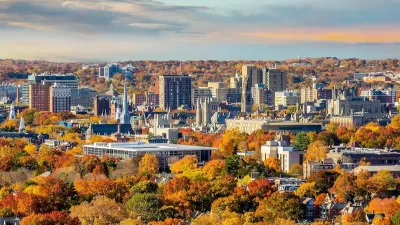A target of 1950s urban renewal, New Haven is looking to rewrite renewal's wrongs by re-connecting the Hill neighborhood with downtown via a highway cap project. Critics complain the project doesn't go far enough to heal the area's historic wounds.
New Haven's Oak Street Connector, a spur of Interstate 95, cuts between the heart of the city's downtown and the medical industry-heavy Hill neighborhood to the southwest. C.J. Hughes, of The New York Times, reports on a promising effort to re-'cross' the highway with 'Downtown Crossing,' "a $135 million redevelopment plan that has been years in the making."
"Echoing recent efforts by San Francisco, Milwaukee and Boston to alter or remove their highways," reports Hughes, "Downtown Crossing targets a one-mile, mostly sunken section of the connector running roughly between Orange and College Streets." Creating ten acres of new developable land, neighborhood stakeholders and city officials hope the project will act as a catalyst for future development, and increase tax revenues for the city.
Critics of the project have targeted its 850-space parking garage, not required of the developer, and what the New Haven Urban Design League sees as a lack of apartments, stores, and transportation options to "create lasting streetfront vitality."
Boosters hope Downtown Crossing is only the first of a wave of commercial development for the New Haven area, where a low 10.6% office vacancy rate sends a clear message that more space is needed.
FULL STORY: A Plan in New Haven to Right a Highway’s Wrong

Planetizen Federal Action Tracker
A weekly monitor of how Trump’s orders and actions are impacting planners and planning in America.

Restaurant Patios Were a Pandemic Win — Why Were They so Hard to Keep?
Social distancing requirements and changes in travel patterns prompted cities to pilot new uses for street and sidewalk space. Then it got complicated.

Maui's Vacation Rental Debate Turns Ugly
Verbal attacks, misinformation campaigns and fistfights plague a high-stakes debate to convert thousands of vacation rentals into long-term housing.

In California Battle of Housing vs. Environment, Housing Just Won
A new state law significantly limits the power of CEQA, an environmental review law that served as a powerful tool for blocking new development.

Boulder Eliminates Parking Minimums Citywide
Officials estimate the cost of building a single underground parking space at up to $100,000.

Orange County, Florida Adopts Largest US “Sprawl Repair” Code
The ‘Orange Code’ seeks to rectify decades of sprawl-inducing, car-oriented development.
Urban Design for Planners 1: Software Tools
This six-course series explores essential urban design concepts using open source software and equips planners with the tools they need to participate fully in the urban design process.
Planning for Universal Design
Learn the tools for implementing Universal Design in planning regulations.
Heyer Gruel & Associates PA
JM Goldson LLC
Custer County Colorado
City of Camden Redevelopment Agency
City of Astoria
Transportation Research & Education Center (TREC) at Portland State University
Camden Redevelopment Agency
City of Claremont
Municipality of Princeton (NJ)





























